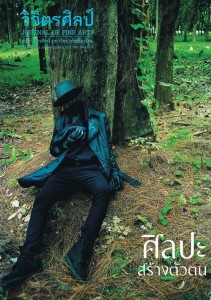การเปลี่ยนแปลงความสัมพันธ์ทางชาติพันธุ์ระหว่างชาวขมุกับไทลื้อ : ศึกษาจากวัฒนธรรมผ้าทอไทลื้อในเมืองเงินแขวงไชยะบุรี สปป.ลาว
Main Article Content
Abstract
บทความเรื่องนี้ม่งุ ศึกษาการเปลี่ยนแปลงความสัมพันธ์ทางชาติพันธ์ุระหว่างชาวขมุกับไทลื้อผ่านวัฒนธรรมผ้าทอไทลื้อในเมืองเงิน แขวงไชยะบุรี สปป.ลาว เพื่อวิเคราะห์ลักษณะและสาเหตุของการเปลี่ยนแปลงความสัมพันธ์ทางชาติพันธุ์ระหว่างชาวขมุกับไทลื้อผ่านวัฒนธรรมผ้าทอไทลื้อ ตลอดจนวิเคราะห์การใช้ความหมายทางวัฒนธรรมของผ้าทอไทลื้อเพื่อแสดงและสร้างอัตลักษณ์ทางชาติพันธุ์
ผลการศึกษาพบว่า วัฒนธรรมผ้าทอไทลื้อเมืองเงินได้เปลี่ยนแปลงอย่างชัดเจนในกระบวนการผลิตผ้าทอ และการเลือกสรรผ้าทอที่เป็นเครื่องแต่งกายเกิดผลกระทบต่อความสัมพันธ์ทางชาติพันธุ์ระหว่างชาวขมุกับไทลื้อ โดยเปลี่ยนจากความสัมพันธ์แบบพึ่งพาซึ่งกันและกันทั้งในด้านสังคมวัฒนธรรมและเศรษฐกิจ สู่ความสัมพันธ์แบบมุ่งเน้นปัจจัยด้านเศรษฐกิจเป็นเรื่องสำคัญทั้งนี้ พบว่ามีสาเหตุหลักมาจากการกำหนดนโยบายของรัฐด้านการพัฒนาเศรษฐกิจและสังคมวัฒนธรรม รวมถึงการเปลี่ยนแปลงสภาพการณ์พื้นที่แนวชายแดนไทย-ลาวที่ได้รับอิทธิพลจากกระแสโลกาภิวัตน์
ในสภาพการณ์เหล่านี้ ผ้าทอไทลื้อในปัจจุบันกลายเป็นตัวแทนทางวัฒนธรรมซึ่งกลุ่มชนทั้งสองรวมถึงทางรัฐพยายามช่วงชิงความหมายของผ้าทอไทลื้อเมืองเงิน เพื่อใช้เป็น “ยุทธวิธี” ในการนำเสนอตัวเองไปตามเงื่อนไขสถานการณ์ และผลประโยชน์ กลายเป็นเครื่องมือในการต่อรองอำนาจระหว่างกลุ่มชน หรือระหว่างรัฐกับกลุ่มชน เช่น ในการหยิบยืมและเลือกใช้เครื่องแต่งกายไทลื้อโดยชาวขมุ การใช้ผ้าทอเป็นเครื่องมือในการสร้าง “อัตลักษณ์ที่สามารถซื้อขายได้ (Marketable Identity)” ของชาวไทลื้อ และการใช้ผ้าเช็ดไทลื้อเมืองเงินเป็นสิ่งแสดง “ความเป็นเมืองเงิน” เชื่อมโยงกับ “เมืองแห่งวัฒนธรรมไทลื้อ” เพื่อรณรงค์การท่องเที่ยวและการค้าของหน่วยงานรัฐในท้องถิ่นแต่กระนั้นผู้เขียนพบว่าทั้งชาวขมุและไทลื้อยังดำเนินพิธีกรรมเกี่ยวกับผีบรรพบุรุษและขวัญ โดยมีผ้าทอเป็นสิ่งที่สื่อความหมายเชิงสัญลักษณ์ในพื้นที่ทางความคิดของตน ซึ่งไม่จำเป็นที่จะต้องช่วงชิงความหมายทางวัฒนธรรมจากใคร
The Change of Ethnic Relations between Khmu and Tai Lue: A Study of Textiles Cultures in Muang Ngoen, Sayabury Province, Lao PDR.
This paper aims to study the change of ethnic relations between Khmu and Tai Lue through textiles culture in Muang Ngoen, Sayabury Province, Lao PDR in order to analyze aspects and its primary causes for the change of ethnic relations between Khmu and Tai Lue through textiles culture as well as its influences towards contesting cultural meaning of the Tai Lue textiles in order to make their ethnic identities.
It is found that the textiles culture in Muang Ngoen have been changed obviously in the process of textiles production and their choice of costumes. These changes have affected ethnic relations between Khmu and Tai Lue, changed from relationship depending on each other by exchanging products to the one emphasizing on monetary economy and trade system, which caused by Lao Government’s economic and social policies as well as social and economic influences from globalization around border areas between Laos and Thailand.
In this situation the Tai Lue textiles have become cultural representation which both Khmu and Tai Lue people as also as the Lao State try to use its cultural meaning as a strategy in order to express their ethnic identities on their specific situations and interests. That makes the textiles will be used for powernegotiation between ethnic groups and/or between ethnic groups and the Lao Government, such as using Tai Lue costumes by Khmu people, using textiles production for making their "Marketable Identity" by Tai Lue people and using Pha Ched (Tai lue shoulder cloth) for making "Muang Ngoen identity" related to Tai Lue culture by local government in order to promote local tourism and trade.
However, it is also found that both Khmu and Tai Lue people in Muang Ngoen still practice spiritual ceremonies on their own "mental space" by using specific textiles as spiritual symbols for representing their ethnic identity. In this "mental space" they don’t have to contest any cultural meanings from others.


